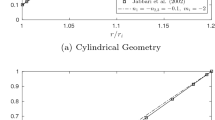We formulate and solve a problem of reconstruction of the unknown time-dependent temperature distribution on one boundary surface of a functionally graded hollow sphere according to the temperature and radial displacements on the other boundary surface. We suggest a procedure reducing the formulated problem to the inverse thermoelasticity problem. By applying the finite-difference method, we construct a numerical algorithm aimed at solving the obtained inverse problem. By using the solution of the direct thermoelasticity problem, we analyze the stability of the obtained solution of the inverse problem and the distributions of displacements and stresses obtained on the basis of this solution against the errors of the input data.
Similar content being viewed by others
References
R. M. Kushnir, V. S. Popovych, and A. V. Yasinskyy, Optimization and Identification in the Thermomechanics of Inhomogeneous Bodies [in Ukrainian], Vol. 5 in: Ya. Yo. Burak and R. M. Kushnir (editors), Modeling and Optimization in the Thermomechanics of Conducting Inhomogeneous Bodies, edited by, , Spolom, Lviv (2011).
O. M. Alifanov, Inverse Heat Transfer Problems, Springer, Berlin (1994).
F. Ashida, S. Sakata, T. R. Tauchert, and Y. Yamashita, “Inverse transient thermoelastic problem for a composite circular disk,” J. Therm. Stresses, 25, No. 5, 431–455 (2002); https://doi.org/10.1080/01495730252890177.
G. Blanc and M. Raynaud, “Solution of the inverse heat conduction problem from thermal strain measurements,” J. Heat Transfer, 118, No. 4, 842–849 (1996); https://doi.org/10.1115/1.2822579.
H.-T. Chen, X.-Y. Wu, and Y.-S. Hsiao, “Estimation of surface condition from the theory of dynamic thermal stresses,” Int. J. Thermal Sci., 43, No. 1, 95–104 (2004); 10.1016/S1290–0729(03)00105-4.
B. H. Dennis, W. Jin, G. S. Dulikravich, and J. Jaric, “Application of the finite element method to inverse problems in solid mechanics,” Int. J. Struct. Changes Solids, 3, No. 2, 11–21 (2011).
G. S. Dulikravich, B. H. Dennis, D. P. Baker, S. R. Kennon, H. R. B. Orlande, and M. J. Colaco, “Inverse problems in aerodynamics, heat transfer, elasticity and materials design,” Int. J. Aeronaut. Space Sci., 13, No. 4, 405–420 (2012); https://doi.org/10.5139/IJASS.2012.13.4.405.
M. R. Golbahar Haghighi, P. Malekzadeh, and M. Afshari, “Inverse estimation of heat flux and pressure in functionally graded cylinders with finite length,” Compos. Struct., 121, 1–15 (2015); 10.1016/j.compstruct.2014.11.025.
K. Grysa and A. Maciag, “Solving direct and inverse thermoelasticity problems by means of Trefftz base functions for finite element method,” J. Therm. Stresses, 34, No. 4, 378–393 (2011); https://doi.org/10.1080/01495739.2010.550818.
R. B. Hetnarski and M. R. Eslami, Thermal Stresses—Advanced Theory and Applications, Springer, Berlin (2009).
V. Kozlov, V. Mazya, and A. Fomin, “The inverse problem of coupled thermoelasticity,” Inverse Probl., 10, No. 1, 153–160 (1994); https://doi.org/10.1088/0266-5611/10/1/012.
H.-L. Lee and Y.-C. Yang, “Inverse problem of coupled thermoelasticity for prediction of heat flux and thermal stresses in an annular cylinder,” Int. Comm. Heat Mass Transfer, 28, No. 5, 661–670 (2001); https://doi.org/10.1016/S0735-1933(01)00270-6.
D. W. Nicholson, “On finite element analysis of an inverse problem in elasticity,” Inverse Probl. Sci. Eng., 20, No. 5, 735–748 (2012); https://doi.org/10.1080/17415977.2012.668677.
N. Noda, F, Ashida, and T. Tsuji, “An inverse transient thermoelastic problem for a transversely isotropic body,” J. Appl. Mech., 56, No. 4, 791–797 (1989); 10.1115/1.3176173.
Y. Ootao, “Inverse problem of thermal deformation in a cylinder,” in: Encyclopedia of Thermal Stresses, edited by R. B. Hetnarski, Springer, Berlin (2014), Vol. 5, pp. 2578–2585; https://doi.org/10.1007/978-94-007-2739-7_223.
A. A. Samarskii and E. S. Nikolaev, Numerical Method for Grid Equations, Vol. I: Direct Methods, Birkhäuser, Basel (1989).
A. E. Segall, D. Engels, and C. Drapaca, “Inverse determination of thermal boundary conditions from transient surface temperatures and strains in slabs and tubes,” Mater. Manuf. Process., 27, No. 8, 860–868 (2012); https://doi.org/10.1080/10426914.2012.663130.
H.-S. Shen, Functionally Graded Materials: Nonlinear Analysis of Plates and Shells, CRC Press, Boca Raton (2009).
J. Taler and P. Duda, Solving Direct and Inverse Heat Conduction Problems, Springer, Berlin (2006).
A. K. Tikhe and K. C. Deshmukh, “Inverse heat conduction problem in a thin circular plate and its thermal deflection,” Appl. Math. Model., 30, No. 6, 554–560 (2006); https://doi.org/10.1016/j.apm.2005.12.014.
Y. V. Tokovyy, “Direct integration method.” in: Encyclopedia of Thermal Stresses, R. B. Hetnarski (editor), Springer, Berlin, 2014, Vol. 2, pp. 951–960; https://doi.org/10.1007/978-94-007-2739-7_621.
Y. C. Yang, U. C. Chen, and W. J. Chang, “An inverse problem of coupled thermoelasticity in predicting heat flux and thermal stresses by strain measurement,” J. Therm. Stresses, 25, No. 3, 265–281 (2002); https://doi.org/10.1080/014957302317262305.
A. V. Yasinskii, “Identification of the thermal and thermostressed states of a two-layer cylinder from surface displacements,” Prikl. Mekh,, 44, No. 1, 40–47 (2008); English translation: Int. Appl. Mech., 44, No. 1, 34–40 (2008); 10.1007/s10778-008-0014-5.
A. V. Yasinskii and R. I. Shipka, “Determination of the axisymmetric thermal field and thermostressed state of a circular plate from its deflection,” Prikl.. Mekh,, 37, No. 8, 118–124 (2001); English translation: Int. Appl. Mech., 37, No. 8, 1075–1082 (2001); 10.1023/A:1013030822563.
A. Yasinskyy, “Determination and optimization of stress state of bodies on the basis of inverse thermoelasticity problems,” in: Encyclopedia of Thermal Stresses, R. B. Hetnarski (editor), Springer, Berlin, 2014, Vol. 2, pp. 916–924; https://doi.org/10.1007/978-94-007-2739-7_607.
A. Yasinskyy and L. Tokova, “Inverse problem on the identification of temperature and thermal stresses in an FGM hollow cylinder by the surface displacements,” J. Therm. Stresses, 40, No. 12, 1471–1483 (2017); https://doi.org/10.1080/01495739.2017.1357455.
Author information
Authors and Affiliations
Corresponding author
Additional information
Translated from Matematychni Metody ta Fizyko-Mekhanichni Polya, Vol. 63, No. 1, pp. 149–160, January–March, 2020.
Rights and permissions
Springer Nature or its licensor (e.g. a society or other partner) holds exclusive rights to this article under a publishing agreement with the author(s) or other rightsholder(s); author self-archiving of the accepted manuscript version of this article is solely governed by the terms of such publishing agreement and applicable law.
About this article
Cite this article
Kushnir, R.M., Yasinskyy, A.V. & Tokovyy, Y.V. Reconstruction of the Thermal Load of a Functionally Graded Hollow Sphere by Surface Displacements. J Math Sci 270, 176–190 (2023). https://doi.org/10.1007/s10958-023-06339-8
Received:
Published:
Issue Date:
DOI: https://doi.org/10.1007/s10958-023-06339-8




